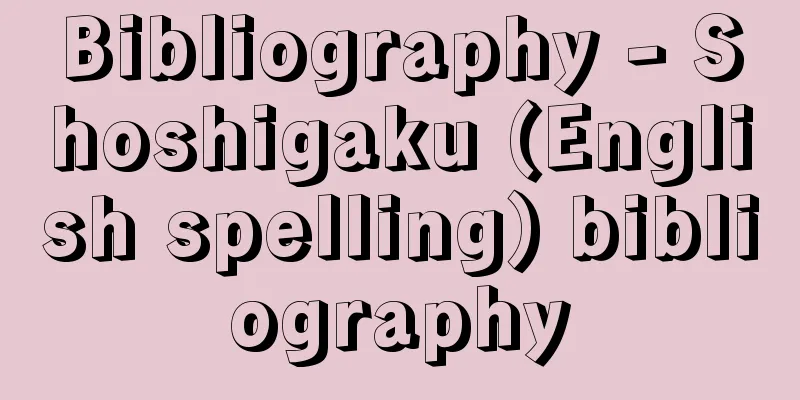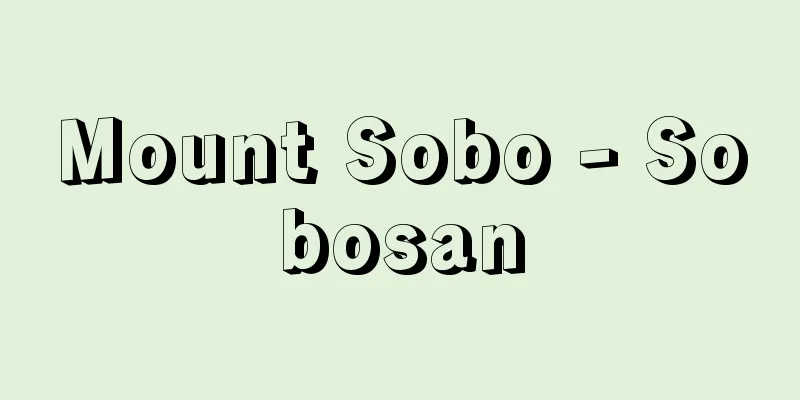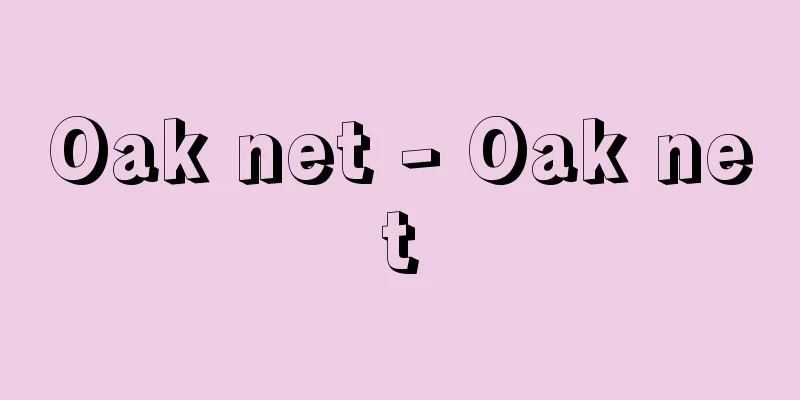Bibliography - Shoshigaku (English spelling) bibliography

|
The word bibliography is derived from the Greek words biblion (book) and graphien (magazine). As can be seen from the etymology, this word originally meant "writing a book," but in the 18th century, when it began to be used in France to mean "writing about books," the old meaning fell into disuse. Then, in the late 19th century in England, when the idea of studying the transmission of literature (analytical bibliography) was added to bibliography, it came to be called neo-bibliography to distinguish it from bibliography that did not include this idea. Current British and American bibliography adopts this idea. The Japanese words bibliography and bibliography are translations of the English word bibliography. [Akira Takano] WesternThe academic field that studies books. The meaning of "book" is completely different between "reading a book" and "using a book as your pillow." The former is concerned with the contents of the book, while the latter refers to the book as an "object." Anglo-American bibliography distinguishes between the treatment of books in this way, dividing bibliography into reference bibliography and material bibliography. The former is enumerative bibliography, while the latter is analytical bibliography. The latter is further divided into descriptive bibliography, textual bibliography, and historical bibliography depending on the purpose of the research (France and Germany do not include Anglo-American analytical bibliography in bibliography). [Akira Takano] BibliographyEnumerative bibliography Library materials contain a variety of knowledge. To effectively disseminate this knowledge, it is necessary to identify the contents of library materials, describe their characteristics, and arrange them in a certain system. This research is called enumerative bibliography, and enumerative bibliographies are a product of it. Bibliographies are compiled for various purposes, but they may be roughly divided into world bibliographies, national bibliographies, subject bibliographies, personal bibliographies, and bibliographies of bibliographies. [Akira Takano] Analytical BibliographyAnalytical bibliography Analytical bibliography studies the physical facts of books, reconstructs the book-making process, and ultimately seeks to solve the problems that each book faces. A book is a communication that conveys the author's thoughts, but many people must go through the process before the manuscript leaves the author's hands and becomes a book. As it passes through the hands of copyists, editors, typesetters, printers, and others, changes occur, consciously or unconsciously. These changes occur during the book's production, so in order to understand the causes, knowledge about the book, such as what characteristics it has and how it was produced, is necessary. This is why bibliography studies books. Reinterpreting the problem of communication as a problem during the book's production means treating the book as a (manufacturing) "thing." Anglo-American bibliography analyzes books from this perspective and tries to derive the cause of the lack of communication from the book itself as a thing. Henry Bradshaw (1831-86), a 19th century British bibliographer, aptly put it, "Let the books speak for themselves." He explained the issue of communication not in terms of meaning or literature, but in terms of the physical evidence of production. The principles he advocated remain the basis of British and American bibliography to this day. It can be said that the significance of bibliography lies here. One example of treating books as objects and letting them speak is the expose of the Wise forgery by John Carter (1905-75) and Graham Pollard (1903-76). They analyzed the type and paper used and proved that the book in question was a forgery. [1] Descriptive bibliography The role of descriptive bibliography is to carry out an analytical bibliographical investigation of all books in a certain edition to determine the physical condition of the books that the printer or publisher originally intended to publish, i.e., the ideal copy. The results are then described and arranged according to the principles of descriptive bibliography. In order to know what the ideal copy looks like, it is necessary to examine as many books as possible. This not only determines the physical condition of each book, but also allows the interrelationships between the books to be understood, making it possible to classify them into editions, printings, issues, or different printings. Sometimes, previously unknown "unrecorded" books may be discovered. From the above, it is clear that there is a fundamental difference between a descriptive bibliography, which describes an ideal book, and a catalog, which describes a specific book. There are examples of catalogs that follow the principles of descriptive bibliography in detail. However, no matter how detailed it is, as long as it describes a specific book, it is still a catalog. In recent years, descriptive bibliographies that include units of different editions have been compiled. Since they take into account the condition of different editions, they also show differences and similarities in the text, making them increasingly important for text bibliography. However, no descriptive bibliographies that cover all books have been compiled. In the research of text bibliography, the interrelationships between books are sometimes revealed, and these are reflected in descriptive bibliographies, so it can be said that the two are complementary. [2] Textual bibliography Textual bibliography treats printed or written characters as "objects" and analyzes their differences from the perspective of production. Its ultimate goal is to provide the principles and materials for editors to edit critical versions (i.e. versions that restore the text that the author intended to convey). [3] Historical bibliography Historical bibliography studies books by utilizing not only physical book materials, but also other materials. This includes biographies of printers, publishers, bookbinders, and typecasters, as well as the history of publishing rights. It should also include analysis of various records owned by printers and publishers. However, historical bibliography is not a broad historical study that encompasses all the history of books. For this reason, a proposal has been made in France in recent years to create a comprehensive research field that includes the history of books from a social and economic perspective, that is, l'histoire du livre (the history of the library), and historical bibliography. [Akira Takano] Japan/ChinaIn Japan, the term bibliography began to be commonly used in the early Showa period. The term bibliography is also used in Korea. The Chinese terms cataloguing, printing, proofreading, and revision, and the Japanese terms book history, philology, and library studies all have roughly the same meaning as bibliography. [Fukui Tamotsu] the purposeIn order to use books as materials for academic research, it is necessary to examine the text and clarify its characteristics. In particular, the text of old books often changes as they are copied and printed over and over again from the time they were written to the present day. This is because characters and sentences are gradually modified through conscious or unconscious miscopying, misprinting, corrections, omissions, and incorrect spelling. Therefore, as a premise for research, it is necessary to pursue a text that is as close as possible to the original form written by the author. However, since the text is easily influenced by the physical properties of the book that contains it, it is necessary to clarify the history of copying, printing, binding, transmission, etc., and its universal or individual characteristics. This is the purpose of bibliographical research. Bibliographical research is distinguished from mere artistic appreciation, antique entertainment, or a hobby in that its ultimate goal is textual criticism, that is, the pursuit of the original text. [Fukui Tamotsu] ContentsThe content and scope of bibliography can be divided into broad bibliography, which includes the aforementioned textual criticism, and narrow bibliography, which focuses mainly on the morphological aspects of books. Bibliography in the narrow sense refers to the study of (1) the origins of books (bamboo slips, wooden tablets, silk cloth, etc.), paper (hemp paper, hishi paper, kozo paper, etc.), binding (scrolls, oribon, detcho binding, etc.), form (large book, pocket book, square book, etc.), (2) type of calligraphy and printing (autograph book, Song Dynasty publication, official edition, etc.), method (collection of books, typeset, facsimile, etc.), style (style of calligraphy, printing system, etc.), (3) collection, organization, preservation, library, librarian, library stamp, etc. of books, and (4) publication, sale, use, etc. In addition to these, bibliography in a broad sense includes research into the circumstances under which a book was created, comparing the texts of various books to clarify similarities and differences, establishing a lineage, and tracing back to the original text. [Fukui Tamotsu] Research MethodologyBibliographical research can be done on any subject, regardless of whether the book is new or old, or whether it is Japanese, Chinese, or Western. However, among various subjects, knowledge of bibliography is particularly necessary for the study of classical literature and history, which have a large number of target books. For this reason, bibliography was once considered a supplementary science to literature and history. Furthermore, the older a book is and the longer it has been handed down, the more likely it is that the text will become distorted, so it is natural that bibliographical research is needed on classics rather than on new books. In terms of methodology, there is no difference between Japanese or Chinese books and Western books. Generally, to obtain correct results through textual criticism, it is necessary to examine the characteristics of the books to be compared and to select as many good books as possible to compare. In order to select good books, knowledge of bibliography in the narrow sense is essential. Bibliography in the narrow sense is an empirical science that is gradually elucidated by broadly investigating the wide variety of existing old books and by comparing and studying their morphological characteristics in detail and accurately. The form of books and the methods of writing and printing have each developed uniquely depending on the region, era, publisher, etc., and each book also shows its own unique changes. Unlike modern mass-produced industrial products, old books are handmade and unique, and various physical changes occur over time. Since information about old books is incomplete, it is necessary to supplement, estimate, and identify them through appraisal. Appraisal is the ability to compare the morphological characteristics of many books, to acquire commonalities and similarities among old books through the accumulation of experience, and to judge the nature of each book based on that. This means that there are many constraints on research, such as it being difficult to train researchers. [Fukui Tamotsu] Research HistoryIn ancient China, during the Han dynasty, Liu Xiang and Liu Xin (32 BC-23 AD), father and son, as well as Ban Gu, collated books and compiled catalogues, after which a book classification system was devised. During the Song dynasty, there was a trend to seek out good books and collate their texts, leading to the creation of commentaries, research into forgeries, and the editing of lost classical texts. During the Qing dynasty, an academic style that empirically studied classics, such as textual criticism and textual criticism, became popular, and from the end of the Qing to the early years of the Republic of China, Yang Shoujing, Ye Dehui and others emerged, and the study of bibliography gradually flourished. Ye Dehui's Shulin Qinghua is a representative work of this kind. This trend was furthered by the investigation of lost books in Japan, the discovery of new materials in Dunhuang and elsewhere, and the publication of collections of book images following the advancement of photoengraving technology. The progress of bibliography in China was quickly introduced to Japan. Catalogs of Buddhist scriptures were frequently compiled in Japan from the Nara period through to the early Heian period. The most famous comprehensive catalog of Chinese books surviving in Japan is the Genzaisho Mokuroku (Catalog of Books Found in Japan), while the Honcho Shojaku Mokuroku (Catalog of Books Published in Japan) is a comprehensive catalog of national books. The proofreading of books had already begun at the end of the Heian period, and ancient Chinese manuscripts surviving in Japan were proofread against Shinto's Song edition. In the Kamakura period, Minamoto Mitsuyuki, Fujiwara Teika, Sengaku and others worked on proofreading the Manyoshu, the Tale of Genji, and imperial anthologies, leaving behind excellent critical copies. From the mid-Edo period onwards, Yamai Kanae (1681-1728) and Yoshida Kangan (Kouton), who were influenced by the scholarship of Qing dynasty texts, began proofreading Chinese books. During the Bunka and Bunsei eras (1804-1830), Ichino Mitsuhiko (Meian) (1765-1826), Hayashi Taira (Jussai), Kondo Morishige (Seisai), Kariya Mochiyuki (Ekisai), Mori Risshi (Kien) and others continued this tradition, investigating and studying rare Chinese books and establishing the study of bibliography. A representative example of this is the Keiseki Hokoshi (A Record of Visits to Classical Texts) by Mori Tateyuki and others. In the Meiji and Taisho eras, there were Wada Tsunashiro, Naito Torajiro (Konan), Shimada Kan (1881-1915) and others, and in the early Showa era, critical textual research of classics became popular in Japanese literary circles. Nagasawa Kikuya, Kawase Kazuma and others formed the Japanese Bibliographical Society in 1931 (Showa 6), and in 1933 the society launched the journal Shosigaku (Bibliography), which published many research papers. In addition, collections of book images and catalogues of useful books were published one after another, and the academic level of bibliography saw a dramatic improvement during this period. In South Korea, the Korean Bibliographical Research Association was established in 1968 and launched the journal Bibliography, and in 1970 the Korean Bibliographical Society was founded. [Fukui Tamotsu] Western Books, by A. Esdale, translated by Takano Akira (1972, Yushodo Shoten) ▽ R.B. McKerrow, An Introduction to Bibliography for Literary Students (1927, Clarendon Press, Oxford) ▽ Philip Gaskell, A New Introduction to Bibliography (1974, Clarendon Press, Oxford) ▽ Fredson Bowers, Principles of Bibliographical Description (1962, Russell & Russell, New York) ▽ Nagasawa, Kikuya, Introduction to Bibliography (1968, Yoshikawa Kobunkan) ▽ Kawase, Kazuma, An Outline of Japanese Bibliography, revised edition (1972, Kodansha) ▽ Nagasawa, Kikuya, A Story of Old Books: An Introduction to Bibliography (1976, Tomiyama Shobo) ©Shogakukan "> Bibliographic classification Source: Shogakukan Encyclopedia Nipponica About Encyclopedia Nipponica Information | Legend |
|
ビブリオグラフィーとはギリシア語のビブリオンbiblion(図書)とグラフィエンgraphien(誌(しる)す)から生まれたことばである。語源からわかるように、このことばは当初「図書を書く」という意味であったが、18世紀に入って、フランスで「図書について書く」という意味に使われるようになると、旧来の意味は廃れていった。そして19世紀末にイギリスで、文献の伝達を研究する(分析書誌学)考え方が書誌学に追加されると、この考え方を含まない書誌学と区別して、新書誌学とよばれるようになった。現在の英米の書誌学はこの考え方をとっている。日本語の書誌学および書誌は英語のビブリオグラフィーの訳語である。 [高野 彰] 西洋図書を研究する学問。「図書を読む」と「図書を枕(まくら)にする」とでは、「図書」の意味はまったく異なる。前者が図書の内容を問題にしているのに対して、後者は「物」としての図書をさしている。英米の書誌学は図書の扱い方をこのように区別し、書誌学を参考書誌学reference bibliographyと物質書誌学material bibliographyに分けている。前者は列挙書誌学のことであり、後者は分析書誌学のことである。後者は研究の目的によって、さらに、記述書誌学、本文書誌学、そして歴史書誌学に分かれる(フランスやドイツでは英米の分析書誌学を書誌学に含めていない)。 [高野 彰] 列挙書誌学enumerative bibliography 図書資料にはさまざまな知識が収められている。この知識を有効に普及させるには図書資料の内容を識別して、特徴を記述し、一定の体系に配列しておく必要がある。こうした研究をするのが列挙書誌学で、列挙書誌はその産物である。書誌はいろいろな目的で編纂(へんさん)されるが、だいたい、世界書誌、全国書誌、主題書誌、個人書誌、そして書誌の書誌に大別できるかもしれない。 [高野 彰] 分析書誌学analytical bibliography 図書の物理的な事実を研究し、図書の製造工程を復原し、最終的には、個々の図書が抱えている問題を解決しようとするのが分析書誌学である。図書は著者の考えを伝える伝達物であるが、著者の手を離れた原稿が図書になるまでにはさまざまな人の手を介在しなければならない。清書職人、編集者、植字工、印刷工などの手を経るうちに、意識的あるいは無意識的に変更が生まれてくるものである。この変更は図書の製造中におこっているので、その原因を解明するには、図書がどんな特徴をもち、どのように製造されたのかといった図書に関する知識が必要である。書誌学が図書のことを研究するのはそのためである。伝達の問題を図書の製造中の問題としてとらえ直すということは、図書を(製造)「物」として扱うことである。英米の書誌学はこの立場で図書を分析し、伝達されない原因を物としての図書自身から導き出そうとする。19世紀のイギリスの書誌学者ヘンリー・ブラッドショーHenry Bradshaw(1831―86)はいみじくも「図書自身に語らせる」と表現した。伝達の問題を、意味とか、文学的に説明するのではなくて、製造上の物的な証拠で説明するのである。彼の唱えた原理は現在も英米の書誌学の基本になっている。書誌学の意義はここにあるといってよいであろう。 図書を物として扱い、その物に語らせた例として引用されるのがカーターJohn Carter(1905―75)とポラードGraham Pollard(1903―76)が行ったワイズ偽作(ぎさく)本の暴露である。彼らは使用された活字と紙を分析し、問題の図書が偽作本であることを実証したのであった。 〔1〕記述書誌学descriptive bibliography ある版のすべての図書を分析書誌学的に調査し、印刷者とか出版者が当初出そうとした図書、すなわち理想本ideal copyの物理的な状態を確定するのが記述書誌学の役目で、その結果を記述書誌学の原則に従って記述し、配列をしたのが記述書誌である。理想本のようすを知るには、できるだけ多くの図書を調べなければならない。そのことによって、各図書の物理的な状態が確定できるだけでなく、図書の相互関係がつかめるので、版、刷、発行あるいは異刷に分類できるようになる。そしてときには、これまで知られていなかった「未記録」のものがみつかるかもしれない。 以上のことから、理想本を記述する記述書誌と、特定本を記述する目録とでは、本質的に違うことが明らかであろう。目録のなかにも記述書誌学の原則に従って詳しく記述している例をみかける。しかし、どんなに詳しくても、特定本の記述である限り、それは目録なのである。 近年、異刷の単位も含めた記述書誌が編纂されるようになった。異刷の状態も考慮することから、本文の異同も示されるので、記述書誌は本文書誌学にとってますます重要になってきている。しかし、すべての図書を網羅した記述書誌が編纂されているわけではない。本文書誌学の研究のなかで図書の相互関係がわかり、それが記述書誌に反映されることもあり、両者は互いに補足しあっているといえる。 〔2〕本文書誌学textual bibliography 印刷された文字や書かれた文字を「物」として扱い、その異同のようすを製造面から分析するのが本文書誌学である。最終的には、編者が批判版(すなわち著者が伝達しようとした本文を復原した版)を編集できるような原理と、その判断材料を用意することを目ざしている。 〔3〕歴史書誌学historical bibliography 歴史書誌学は物としての図書資料だけでなく、それ以外の資料も活用して図書を研究する。このなかには、印刷者、出版者、製本師、活字鋳造師などの伝記とか、版権の歴史などが含まれている。それに、印刷者とか出版者が所有する各種の記録類の分析も入るはずである。しかし歴史書誌学は、図書に関するすべての歴史を包含した広義の歴史研究ではない。そのため、近年フランスで提唱された、社会・経済面からみた図書の歴史、すなわち、l'histoire du livre(図書史)と、歴史書誌学を含めた総合的な研究分野の創設が提案されている。 [高野 彰] 日本・中国わが国では書誌学の語は昭和初年から一般に使用されるようになった。韓国でも書誌学の語が用いられている。中国の目録学・版本(はんぽん)学・校勘(こうかん)学・校讐(こうしゅう)学、わが国の書史学・文献学・図書学などの語も、書誌学とほぼ同様の内容である。 [福井 保] 目的学術研究の資料として図書を使用するためには、その本文を吟味し、その性質を明らかにする必要がある。ことに、成立の古い図書は、著作されてから今日まで、書写・印刷を重ねて伝来する間に、その本文が変化することが多い。意識的または無意識的な誤写、誤刻、補訂、脱漏、錯簡(さっかん)などによって、しだいに文字や文章が改められるからである。そのため、研究の前提として、できるだけ著者が著した原形に近い本文を追求する必要がある。ところが、本文はその入れ物である図書の物理的な性質に左右されやすいから、書写、印刷、装丁、伝来などの歴史と、その普遍的または個別的な特徴を明らかにすることが必要である。これが書誌学研究の目的である。書誌学の研究は本文批判すなわち原形本文の追求を究極の目的とする点において、単なる美術的鑑賞や骨董(こっとう)的愛玩(あいがん)または好事(こうず)的趣味と区別される。 [福井 保] 内容書誌学の内容、範囲には、前述の本文批判を含める広義の書誌学と、図書の形態的側面を主とする狭義の書誌学とがある。狭義の書誌学とは、(1)図書の起源(竹簡(ちっかん)・木牘(もくとく)・絹布など)、料紙(麻紙(まし)・斐紙(ひし)・楮紙(ちょし)など)、装丁(巻子(かんす)本・折(おり)本・粘葉(でっちょう)装など)、形態(大本(おおほん)・袖珍(しゅうちん)本・枡形(ますがた)本など)、(2)書写および印刷の種類(自筆本・宋刊(そうかん)本・官版(かんぱん)など)、方法(寄合書(よりあいがき)・活字版・影印(えいいん)本など)、様式(書風・版式など)、(3)図書の収集、整理、保存、文庫、蔵書家、蔵書印など、(4)出版、販売、利用など、についての研究である。これらに、図書の成立事情や、諸本の本文を比較して異同を明らかにし、系統をたて、原形本文にさかのぼる研究を加えたものが広義の書誌学である。 [福井 保] 研究法書誌学の研究は対象図書の主題、新旧や和漢洋書の別を問わない。しかし、各種主題のなかでは、対象図書の多い古典文学や歴史学の研究について、書誌学の知識がとくに必要である。そのため、書誌学はかつては文学や歴史学の補助学と考えられていた。また、本文の乱れは、図書の成立が古く、伝来が長いほど生じやすいから、新刊書よりも古典についての書誌学研究が必要とされるのは当然である。書誌学研究の方法論のうえでは、和漢書と洋書との間に差異はない。 一般に、本文批判によって正しい結果を得るためには、比較する図書の性質を吟味し、できるだけ善本を選んで対校(たいこう)する必要がある。善本を選択するためには狭義の書誌学の知識が不可欠である。狭義の書誌学は、現存する多種多様の古書を広く調査し、その形態上の特徴を詳細、正確に比較、研究することによってしだいに究明される実証的な学問である。図書の形態や書写・印刷の方法は、地域、時代、出版者などによってそれぞれ独自の発達を遂げるとともに、そのなかでの個々の図書にはまた独自の変化がみられる。古書は近代の大量工業製品と異なって、手作りで個性的であり、また時間の経過に伴う各種の物理的変化も生ずる。古書はそれ自身についての情報が不備であるから、これを鑑識によって補い、推定、鑑別する必要がある。その鑑識とは、多数の図書の形態的特徴を比較し、その経験の蓄積によって古書の共通性や類似性を会得し、それに基づいて個々の図書の性質を判断する能力である。そのため研究者の養成が容易でないなど研究上の制約が多い。 [福井 保] 研究史中国では古く漢代に劉向(りゅうきょう)・劉歆(りゅうきん)(前32―後23)父子や班固(はんこ)らが図書の校勘や目録の編集を行い、その後、図書分類法が考案された。宋(そう)代には善本を求めてその本文を校勘する風潮がおこり、解題書がつくられ、偽書の研究や、すでに散逸した古典の逸文の編集も行われた。清(しん)代には考証学、考勘学など古典を実証的に研究し、その本文批判を行う学風が流行し、清末から民国初年にかけて楊守敬(ようしゅけい)、葉徳輝(しょうとくき/せっとくき)らが出て、しだいに書誌学の研究が隆盛となった。葉徳輝の『書林清話』はその代表的な著述である。わが国における佚存書(いっそんしょ)の調査、敦煌(とんこう)その他における新資料の発見、写真製版技術の進歩に伴う書影集の刊行などがその傾向を助長した。中国における書誌学の進歩は直ちにわが国にも伝えられた。 わが国では奈良時代から平安初期にかけて仏典の目録がしばしば編集された。わが国に伝存する漢籍の総目録では『日本国見在書(げんざいしょ)目録』が、また国書の総目録では『本朝書籍(しょじゃく)目録』が著名である。平安末期にはすでに図書の校勘が始まり、わが国に伝存する漢籍の古写本と新渡の宋刊本との校勘が行われた。国書については鎌倉時代に源光行(みつゆき)、藤原定家(ていか)、仙覚(せんがく)らが出て『万葉集』『源氏物語』、勅撰(ちょくせん)集などの校勘に従事し、優れた校本を残した。江戸中期以後、清朝考証学の影響を受けた山井鼎(かなえ)(1681―1728)、吉田漢宦(かんがん)(篁墩(こうとん))らによって漢籍の校勘が始められ、文化・文政(ぶんかぶんせい)年間(1804~30)以後、市野光彦(いちのみつひこ)(迷庵(めいあん))(1765―1826)、林衡(たいら)(述斎(じゅっさい))、近藤守重(もりしげ)(正斎(せいさい))、狩谷望之(かりやもちゆき)(棭斎(えきさい))、森立之(りっし)(枳園(きえん))らが出てその伝統を受け継ぎ、漢籍の善本を調査・研究し、書誌学の研究が確立した。森立之らによる『経籍訪古志(けいせきほうこし)』はその代表的な業績である。明治・大正時代には和田維四郎(つなしろう)、内藤虎次郎(とらじろう)(湖南(こなん))、島田翰(かん)(1881―1915)らがあり、昭和初年には国文学界に古典の本文批判的研究が流行した。長澤規矩也(ながさわきくや)、川瀬一馬(かずま)らは1931年(昭和6)に日本書誌学会を結成し、33年に同会から雑誌『書誌学』を創刊して多数の研究論文を発表した。そのほか、書影集や善本目録なども相次いで刊行されたので、書誌学の学術的な水準はこの時期に画期的な向上をみた。 韓国でも1968年に韓国書誌研究会が発足して雑誌『書誌学』を創刊し、70年には韓国書誌学会が創立された。 [福井 保] 『A・エズデイル著、高野彰訳『西洋の書物』(1972・雄松堂書店)』▽『R. B. McKerrowAn Introduction to Bibliography for Literary Students (1927, Clarendon Press, Oxford)』▽『Philip GaskellA New Introduction to Bibliography (1974, Clarendon Press, Oxford)』▽『Fredson BowersPrinciples of Bibliographical Description (1962, Russell & Russell, New York)』▽『長澤規矩也著『書誌学序説』(1968・吉川弘文館)』▽『川瀬一馬著『日本書誌学概説』増訂版(1972・講談社)』▽『長澤規矩也著『古書のはなし――書誌学入門』(1976・冨山房)』 ©Shogakukan"> 書誌学の分類 出典 小学館 日本大百科全書(ニッポニカ)日本大百科全書(ニッポニカ)について 情報 | 凡例 |
Recommend
Synthetic preservatives - Synthetic preservatives
Among food additives, chemical substances added to...
Langobarden
...As a result, many of the stadts were tribal gr...
Youxian (English spelling)
In China, it refers to traveling to the world of i...
Gordon Riot - Gordon Riot
The largest riot in British history occurred in Lo...
Kyoto Magistrate's Office - Kyoto Machibugyosho
…After Toshitsugu Tsuchiya became the magistrate ...
Japan Socialist Party
Founded on November 2, 1945 (Showa 20) by members...
Gogaku - Gogaku
Also called Gogakko, Gogakusho, or Gogakko. A type...
Ofushi Powder - Ofushiko
…The recipe for making okonomiyaki at that time w...
Mme. Voisin (English spelling)
…The incident involving Grandier (the demon posse...
Amagasaki Spinning - Amagasaki Spinning
…Head office: Chuo-ku, Osaka. Nichibo Co., Ltd. w...
Xiyin Village Ruins - Xi-yin-cun
A site of the Neolithic Yangshao culture in Xia Co...
Operon theory - operon theory
This hypothesis was proposed by JF Jacob and JL Mo...
RCA - RCA
A long-established American company in the broadc...
Indian Runner
...Famous ducks include the Peking Duck (illustra...
Amphiblastura - Amphiblastura
…The fertilized egg undergoes cleavage, and when ...









